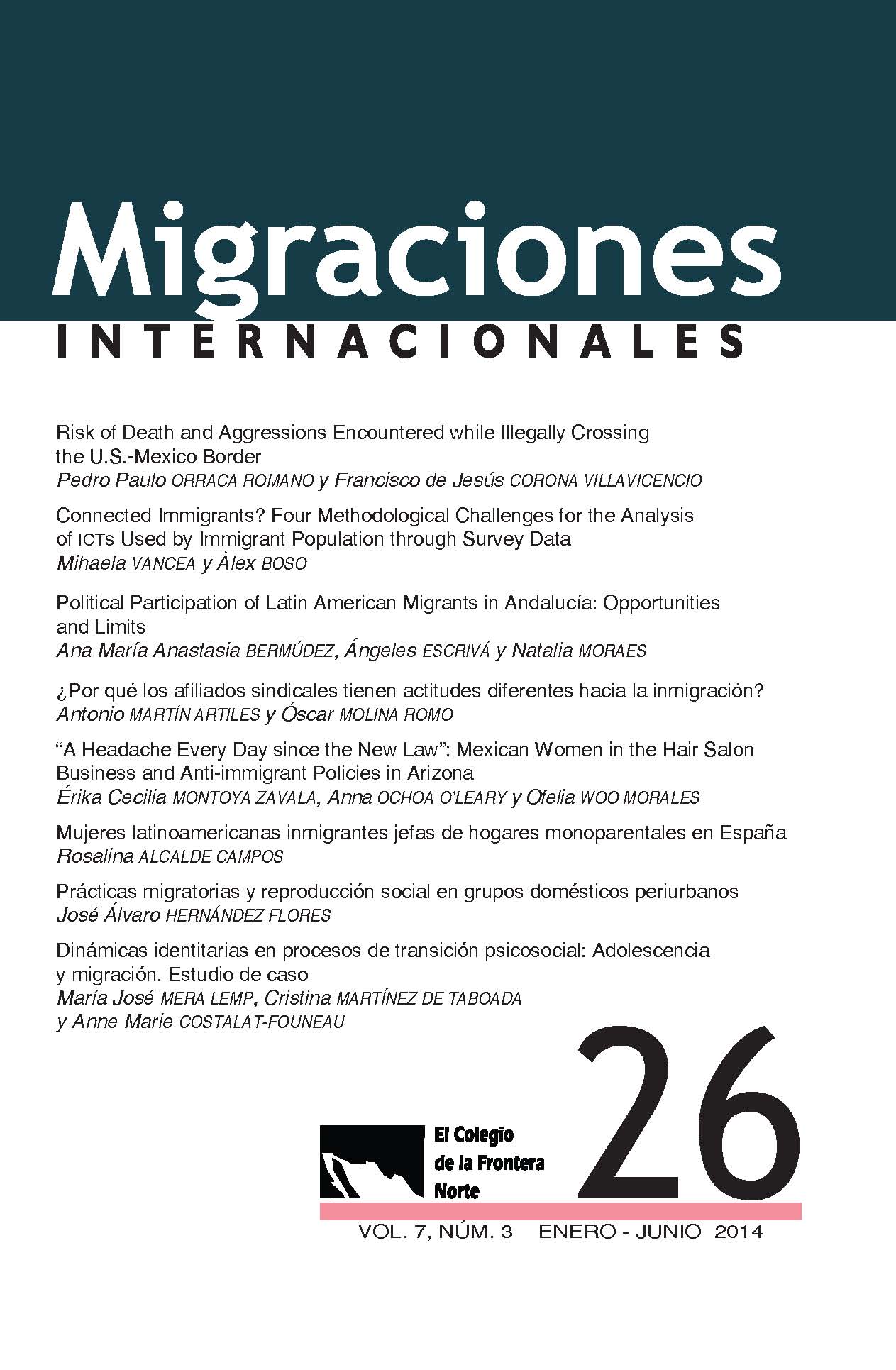“A Headache Every Day since the New Law”: Mexican Women in the Hair Salon Business and Anti-immigrant Policies in Arizona
DOI:
https://doi.org/10.17428/rmi.v7i26.673Palabras clave:
women, immigration policies, self-employment, beauty salons, ArizonaResumen
This paper analyzes the involvement of Mexican women in the formal and informal self-employment sector in a large metropolitan area of Arizona. Qualitative research is used to explore factors that impact self-employment activities of Mexican immigrant women in light of Arizona’s emerging policies aimed at controlling immigration. These policies seek to make it more difficult for undocumented immigrants to access employment opportunities. Women’s testimonials highlight the “headaches” caused by participating in the labor market amid growing restrictions, as well as the creative, hybrid forms of self-employment that combine both formal and informal markets and practices.
“Un dolor de cabeza constante desde la aprobación de la nueva ley”: Mujeres mexicanas en el negocio de salones de belleza y las políticas antiinmigrantes en Arizona
Resumen
En este trabajo se analiza la participación de las mujeres mexicanas en el sector formal e informal de autoempleo, en un área metropolitana de Arizona. Se utilizó un análisis cualitativo para descubrir los factores que afectan las actividades de autoempleo de las inmigrantes mexicanas, a la luz de las nuevas políticas de Arizona dirigidas a controlar la inmigración y limitar el acceso al empleo para los inmigrantes indocumentados. Los testimonios de mujeres migrantes destacan el “dolor de cabeza” que viven al participar en el mercado de trabajo en medio de las crecientes restricciones, así como las formas creativas de implementar trabajos por cuenta propia en los mercados formales e informales.
Descargas
Referencias
AMERICAS SOCIETY AND COUNCIL OF THE AMERI-
CAS (AS AND COA) [digital publication], 2011, “The Eco-
nomic Impact of Immigrant-Related Local Ordinances”, New
York, Americas Society. Available at <http://www.as-coa.org/
sites/default/files/ASImmigrationWhitePaper.pdf> (last access-
ed on March 24, 2012).
ARIZA, Marina [paper], 2008, “Migración y mercados de traba-
jo femeninos en el contexto de la globalización: Trabajadoras
latinas en el servicio doméstico en Madrid y Nueva York”, in
“III Congress of the Asociación Latinoamericana de Población”,
Córdoba, Argentina, September 24-25.
BARROS NOCK, Magdalena, 2006, “Entrepreneurship and
Gender Relations. The Case of Mexican Migrants in Rural
California”, in “Second International Symposium on Migra-
tion and Development: Migration, Transnationalism and So-
cial Transformation”, Cocoyoc, Mexico, October 25-28.
BARROS NOCK, Magdalena, 2009, “Swap Meet and Socio-economic Alternatives for Mexican Immigrants: The Case of
the San Joaquin Valley”, Human Organization, vol. 68, no. 3,
pp. 307-317.
BBVA RESEARCH, 2010, “Migration Outlook Mexico”, bbva
Research/bbva Bancomer Foundation. Available at
www.bbvaresearch.com/KETD/f bin/mult/101025_PresentationsMexico_66_eng_tcm348-234645.pdf?ts=
> (last accessed on October 25, 2011).
CONSEJO NACIONAL DE POBLACIÓN (CONAPO), 2009,
“Capítulo xi. Migración internacional”, Informe de ejecución del
Migraciones internacionales 26.indd 158 24/02/2014 06:55:50 p. m.
montoya-o'leary-woo/“A Headache Every Day since the New Law” 159
Programa de Acción de la Conferencia Internacional sobre la
Población y el Desarrollo 1994-2009, Mexico, Conapo, pp. 241-
Available at <http://www.conapo.gob.mx/publicaciones//
cipd15/WEB_CIPD15.pdf> (last accessed on March 13, 2012).
CORNELIUS, Wayne, 1982, “Interviewing Undocumented Immigrants: Methodological Reflections Based on Fieldwork in Mexico and the U.S.”, International Migration Review, vol. 16,
no. 2, Summer, pp. 378-411.
DONNELLY, Robert, 2012, “State-Level Immigrant-Related
Legislation: What it Means for the Immigration Policy De-
bate”, in Mónica Verea, ed., Antiimmigrant Sentiments, Actions
and Policies in North America and the European Union, Mexico,
cisan-unam, pp. 123-136.
DOWNES, Lawrence, 2013, “Arizona’s Illegal Sheriff”, The New
York Times, in “The Opinion Pages”, March, 25. Available at
<http://takingnote.blogs.nytimes.com/2013/05/25/arizonas-
illegal-sheriff/> ((last accessed on January, 2014).
FIX, Michael and Wendy ZIMMERMANN, 2001, “All under
One Roof: Mixed-Status Families in an Era of Reform”, International Migration Review, vol. 35, no. 2, pp. 397-419.
GANS, Judith, 2008, Immigrants in Arizona: Fiscal and Economic
Impact, Tucson, U.S., University of Arizona/Udall Center Immigration Policy Program Report.
GILBERT, Liette and Kathy A. KOLNICK, 2012, “Constitutional Failure or Anti-immigrant success? Local Anti-immigrant Ordinances and Sentiments in the United States”, in Mónica
Verea, ed., Antiimmigrant Sentiments, Actions and Policies in
North America and the European Union, Mexico, cisan/unam,
pp. 83-102.
GIORGULI SAUCEDO, Silvia E.; Selene Gaspar OLVERA,
and Paula LEITE, 2007, La migración mexicana y el mercado de
trabajo estadounidense. Tendencias, perspectivas y ¿oportunidades?, Mexico, Segob/Conapo.
GOLDSMITH, Pat et al., 2009, “Ethno-Racial Profiling and
State Violence in a Southwest Barrio”, Aztlán: A Journal of Chicano Studies, vol. 34, no. 1, pp. 93-124.
GUPTA, Akhil and James FERGUSON, eds., 1997, Culture/
Power/Place: Explorations in Critical Anthropology, Durham,
United States, Duke University Press.
HARNETT, Helen, 2008, “State and Local Anti-immigrant Initiatives: Can They Withstand Legal Scrutiny?”, Widener Law
Journal, no. 17, pp. 365-382.
HERNÁNDEZ-TRUYOL, Berta Esperanza, 1998, “Culture and
Economic Violence”, in Richard Delgado and Jean Stefancic,
eds., The Latino/a Condition: A Critical Reader, New York/London, New York University Press, pp. 536-542.
HONDAGNEU-SOTELO, Pierrette, 2001, “Trabajando ‘sin papeles’ en Estados Unidos: Hacia la integración de la calidad mi-
gratoria en relación a consideraciones de raza, clase y genero”,
in Esperanza Tuñón Pablos, coord., Mujeres en las fronteras:
Trabajo, salud y migración, Tijuana, El Colegio de la Frontera
Norte, pp. 205-231.
HWAN-OH, Jong, 2007, “Economic Incentive, Embeddedness
and Social Support: A Study of Korean-owned Nail Salon
Workers’ Rotating Credit Associations”, International Migration Review, vol. 41, no. 3, pp. 623-655.
KEARNEY, Michael, 1995, “The Local and the Global: The
Anthropology of Globalization and Transnationalism”, Annual
Review of Anthropology, no. 24, pp. 547-565.
LIGHT, Ivan, 2007, “Economías étnicas”, in Joaquín Beltrán,
Laura Oso, and Natalia Ribas, coords., Empresariado étnico
en España, Madrid, Ministerio de Trabajo y Asuntos Sociales/
Fundación cidob, pp. 41-68.
LIGHT, Ivan and Elsa von SCHEVEN, 2008, “Mexican Migration Networks in the United States, 1980-2000”, International Migration Review, vol. 42, no. 3, pp. 704-728.
MONTOYA ZAVALA, Erika Cecilia, 2011, “Migración y participación laboral de las sinaloenses en Phoenix, Arizona. Desigualdad laboral y salarial por género y estatus migratorio”,
MONTOYA ZAVALA, Erika Cecilia, 2013, “Women, Migrants,
Undocumented Business Owners: Methodological Strategies
montoya-o'leary-woo/“A Headache Every Day since the New Law” 161
in Fieldwork with Vulnerable Populations”, in Anna Ochoa
O’Leary, Colin Deeds and Scott Whiteford, eds., Uncharted Terrains: New Directions in Border Research Methodology,
Ethics, and Practice, Tucson, University of Arizona Press, pp.
-221.
NATIONAL CONFERENCE OF STATE LEGISLATURES
(NCSL), 2011, “Immigrant Policy Project”, The National Conference of State Legislatures. Available at <http://www.ncsl.org/
default.aspx?tabid=19897> (last accessed on March 23, 2012).
O’LEARY, Anna Ochoa, 2006, “Social Exchange Practices among
Mexican-origin Women in Nogales, Arizona: Prospects for Education Acquisition”, Aztlán: A Journal of Chicano Studies, vol.
, no. 1, pp. 63-94.
O’LEARY, Anna Ochoa, 2007, “Petit Apartheid in the U.S.-
Mexico Borderlands: An Analysis of Community Organization
Data Documenting Workforce Abuses of the Undocumented”,
Forum on Public Policy, Winter.
O’LEARY, Anna Ochoa, 2009, “Arizona’s Legislative-Imposed
Injunctions: Implications for Immigrant Civic and Political
Participation”, Mexico, Institute-Woodrow Wilson Center for
Scholars, January (Research Paper Series on Latino Immigrant
Civic and Political Participation, no. 2). Available at
www.wilsoncenter.org/sites/default/files/Tuscon%20Eng.pdf>
(last accessed on March 23, 2012).
O’LEARY, Anna Ochoa and Azucena SANCHEZ, 2011, “Anti-
Immigrant Arizona: Ripple Effects and Mixed Immigration
Status Households under ‘Policies of Attrition’ Considered”,
Journal of Borderlands Studies, vol. 26, no. 1, pp. 115-133.
O’LEARY, Anna Ochoa and Azucena SANCHEZ, 2012, “Mixed
Immigration Status Households in the Context of Arizona’s
Anti-immigrant Policies”, in Mónica Veréa, ed., Antiimmigrant
Sentiments, Actions and Policies in North America and the European Union, Mexico, cisan-unam, pp. 157-174.
O’LEARY, Anna Ochoa; Norma E. GONZÁLEZ, and Gloria
Ciria VALDEZ-GARDEA, 2008, “Latinas’ Practices of Emergence: Between Cultural Narratives and Globalization on the U.S.-Mexico Border”, Journal of Latinos and Education, vol. 7, no. 3, July, pp. 206-226.
OSO, Laura and Natalia RIBAS, 2007, “Empresariado étnico
y relaciones de género: Mujeres dominicanas y marroquíes en
Madrid y Barcelona”, Joaquín Beltrán, Laura Oso, and Natalia
Ribas, coords., Empresariado étnico en España, Barcelona, Ministerio de Trabajo y Asuntos Sociales/Fundación cidob, pp.
-228.
PARREÑAS, Rhacel Salazar, 2001, Servants of Globalization:
Women, Migration and Domestic Work, Palo Alto, United States,
Stanford University Press.
PEW HISPANIC CENTER, 2008, “Arizona: Population and
Labor Force Characteristics, 2000-2006”, Pew Hispanic Center. Available at <http://pewhispanic.org/files/factsheets/37.pdf>
PASSEL, Jeffrey S. and D’Vera COHN [report], 2009, “A Portrait of Unauthorized Immigrants in the United States”, Washington, DC, The Pew Hispanic Center.
PLASCENCIA, Luis, 2009, “The ‘Undocumented’ Mexican Migrant Question: Re-examining the Framing of Law and Illegalization in the United States”, Urban Anthropology, vol. 38, no.
-4, pp. 375-434.
RIVERA-BATIZ, Francisco L., 1999, “Undocumented Workers
in the Labor Market: An Analysis of the Earnings of Legal and
Illegal Mexican Immigrants in the United States”, Journal of
Population Economics, vol. 12, no. 1, pp. 91-117.
ROMERO, Mary, 2008, “The Inclusion of Citizenship Status
in Intersectionality: What Immigration Raids Tell Us about
Mixed-status Families, the State, and Assimilation”, International Journal of the Family, vol. 34, no. 2, pp. 131-152.
STATE OF ARIZONA SENATE, 2007, Legal Arizona Workers
Act. Arizona Revised Statutes §13-2009 and §23-211-216. State
of Arizona Senate, House of Representatives, 48th Legislature,
st Regular Session, July 2.
STATE OF ARIZONA SENATE, 2008, Arizona House Bill
Arizona Revised Statutes §§23-215, 41-1080, 43-1021;
montoya-o'leary-woo/“A Headache Every Day since the New Law” 163
-1121, State of Arizona Senate, House of Representatives,
th Legislature, 2nd Regular Session, May 1.
State of Arizona Senate, 2010, Senate Bill 1070, Fortyninth Legislature of the State of Arizona Senate, Second Regu-
lar Session. Available at <http://www.azleg.gov/legtext/49leg/
r/bills/sb1070s.pdf> (last accessed on March 13, 2012).
SURVEY OF BUSINESS OWNERS (SBO), 2007, “Summary
Statistics for Mexican-Owned Firms by State”, Washington,
DC, U.S. Department of Commerce. Available at
www.census.gov/econ/sbo/07menu.html> (last accessed on Oc-
tober 14, 2011).
TYNER, JAMES, 1996, “The Gendering of Philippine Migra-
tion”, Professional Geographer, vol. 48, no. 4, pp. 405-416.
U.S. CENSUS BUREAU, 2008, “Utah is Fastest-Growing State”,
U.S. Census Bureau, Washington, DC, U.S. Department of
Commerce. Available at <http://www.census.gov/newsroom/
releases/archives/population/cb08-187.html> (last accessed on
May 5, 2012).
U.S. CENSUS BUREAU, 2011, “The Hispanic Population:
”, U.S. Census Bureau, Washington, DC, U.S. Depart-
ment of Commerce. Available at <http://www.census.gov/
prod/cen2010/briefs/c2010br-04.pdf> (last accessed in November, 2013).
U.S. Congress, 1986, Immigration Reform and Control Act
(irca), Pub. L. 99-603, 100 Stat. 3445, 99th Congress, 2nd Session, November 6.
U.S. Congress, 1996, Illegal Immigration Reform and Immigrant Responsibility Act, Pub. L. 104-208; 110 Stat. 3009-546.
th U.S. Congress, September 30.
VALDEZ-GARDEA, Gloria Ciria; Anna Ochoa O’LEARY, and
Norma E. GONZÁLEZ, 2011, “El trabajo flexible y la baja
inversión en la educación de las mujeres de la frontera EEUU-
México”, Región y Sociedad, vol. xxiii, no. 50, pp. 23-54.
VALDEZ, Zulema, 2011, The New Entrepreneurs, How Race,
Class and Gender Shape American Enterprise, Stanford, United
States, Stanford University Press.
VALENZUELA CAMACHO, Blas, 2007, “Encuesta a hogares mexicanos en Phoenix, Arizona (ehmpa)” [project Fomix
Conacyt Sin-2006-CO1-42103 and Profapi 2007/130], Sinaloa, Mexico, uas.
VALENZUELA CAMACHO Blas and Bribrilia COTA, 2012,
“Los microempresarios mexicanos en Phoenix, Arizona:
¿Quiénes son y a qué se dedican?”, in Blas Valenzuela and Erika Cecilia Montoya, coords., Nuevos senderos, mismo destino.
VALENZUELA CAMACHO, Blas and Erika Cecilia MONTOYA, 2012, coords., Nuevos senderos, mismo destino. Migración mexicana en Phoenix, Arizona, Mexico, Jorale Editores.
VALENZUELA JR., Abel, 2002, “Working on the Margins in
Metropolitan Los Angeles: Immigrants in Day Labor Work”,
VÉLEZ-IBÁÑEZ, Carlos G., 1983, Bonds of Mutual Trust: The
Cultural Systems of Rotating Credit Associations among Urban
Mexicans and Chicanos, New Brunswick, United States, Rutgers University Press.
WILSON, Tamar, 2000, “Anti-immigrant Sentiment and the
Problem of Reproduction/Maintenance in Mexican Immigration to the United States”, Critique of Anthropology, vol. 20, no.
, pp. 191-213.
WINGFIELD, Adia Harvay, 2008, Doing Business with Beauty.
Black Women, Hair Salons, and the Racial Enclave Economy,
New York, Rowman and Littlefield Publishers.
Descargas
Publicado
Número
Sección
Licencia
Las/los autoras/es que publiquen en esta revista aceptan las siguientes condiciones:
- Las/los autoras/es conservan los derechos de autor y ceden a la revista Migraciones Internacionales (RMI) el derecho de la primera publicación, mediante el registro de los textos con la licencia de Creative Commons Atribución-No comercial-Sin derivar 4.0 internacional (CC BY-NC-ND 4.0), que permite a terceros utilizar lo publicado siempre que mencionen la autoría del trabajo y a la primera publicación en esta revista.
- Autorizan que su artículo y todos los materiales incluidos en él sean reproducidos, publicados, traducidos, comunicados y transmitidos públicamente en cualquier forma o medio; así como efectuar su distribución al público en el número de ejemplares que se requieran y su comunicación pública, en cada una de sus modalidades, incluida su puesta a disposición del público a través de medios electrónicos o de cualquier otra tecnología, para fines exclusivamente científicos, culturales, de difusión y sin fines comerciales.
- Los autores/as pueden realizar otros acuerdos contractuales independientes y adicionales para la distribución no exclusiva de la versión del artículo publicado en esta revista (por ejemplo: incluirlo en un repositorio institucional, página web personal; o bien publicarlo en un libro) siempre que sea sin fines comerciales e indiquen claramente que el trabajo se publicó por primera vez en Migraciones Internacionales (RMI), [agregando la ficha bibliográfica correspondiente: Autor/es. (año). Título del artículo. Migraciones Internacionales, volumen (número), pp. doi: xxxx ].
Para ello, las/los autoras/es deben remitir el formato de carta-cesión de la propiedad de los derechos de la primera publicación debidamente llenado y firmado. Este documento debe cargarse en formato PDF en archivos complementarios dentro de la plataforma OJS.
Este obra está bajo una licencia de Creative Commons Atribución-No comercial-Sin derivar 4.0 internacional (CC BY-NC-ND 4.0)..













